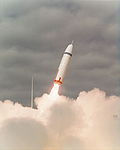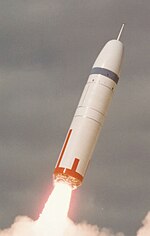Search results
Appearance
There is a page named "Trident" on Wikipedia
- A trident (/ˈtraɪdənt/) is a three-pronged spear. It is used for spear fishing and historically as a polearm. As compared to an ordinary spear, the three...25 KB (2,461 words) - 04:33, 10 June 2024
- Trident, also known as the Trident nuclear programme or Trident nuclear deterrent, covers the development, procurement and operation of nuclear weapons...125 KB (13,105 words) - 16:50, 13 June 2024
- The Trident missile is a submarine-launched ballistic missile (SLBM) equipped with multiple independently targetable reentry vehicles (MIRV). Originally...24 KB (2,506 words) - 12:56, 23 June 2024
- The UGM-133A Trident II, or Trident D5 is a submarine-launched ballistic missile (SLBM), built by Lockheed Martin Space in Sunnyvale, California, and deployed...38 KB (3,764 words) - 16:00, 25 June 2024
- The Hawker Siddeley HS-121 Trident (originally the de Havilland DH.121 and briefly the Airco DH.121) is a British airliner produced by Hawker Siddeley...58 KB (7,582 words) - 14:03, 18 June 2024
- The UGM-96 Trident I, or Trident C4, was an American submarine-launched ballistic missile (SLBM), built by Lockheed Martin Space Systems in Sunnyvale...3 KB (220 words) - 14:04, 5 June 2024
- Look up trident in Wiktionary, the free dictionary. A trident is a three-pronged staff. Trident may also refer to: The Trident, a mountain in South Georgia...4 KB (601 words) - 02:28, 7 June 2024
- Operation Trident may refer to: Operation Trident (1963), a military operation during the Portuguese Colonial War in Guinea in 1964 Operation Trident (1971)...471 bytes (88 words) - 01:25, 31 December 2019
- The trident of Poseidon and his Roman equivalent, Neptune, has been their traditional divine attribute in many ancient depictions. Poseidon's trident was...13 KB (1,341 words) - 06:41, 26 June 2024
- Trident Football Club, is a Zambian football club that competes since summer 2023 for the first time in the Zambia Super League. Founded in 2015, the...3 KB (293 words) - 16:31, 6 February 2024
- Trident is a brand of sugar-free chewing gum. It was originally introduced by American Chicle in 1960 shortly before it was bought by Warner-Lambert in...7 KB (692 words) - 06:03, 14 April 2024
- types, which are Trident 1, Trident 2, Trident 3, and Trident 4. They are mostly built between 1984 and 1992. Most Trident blocks are used as public housing...11 KB (900 words) - 14:11, 28 June 2024
- British replacement of the trident system)ballistic missile submarines. Like their predecessors they will carry Trident II D-5 missiles. The Vanguard submarines entered service in the United...22 KB (1,882 words) - 14:21, 6 May 2024Trident Volcano is an eroded volcanic complex on the Alaska Peninsula in Katmai National Park, Alaska. Up to 23 domes comprise the complex stratovolcano...5 KB (449 words) - 04:24, 25 April 2024
- Navy Special Warfare Trident)The Special Warfare insignia, also known as the "SEAL Trident" or its popular nickname in the Navy community, "The Budweiser", recognizes those members...4 KB (369 words) - 21:17, 22 January 2024
- curve impossible trident tridental tridentlike trident bat three-pronged spear trisula (Hindu trident) tryzub (Ukrainian trident) Trident curve on Wikipedia
- 1911 Encyclopædia Britannica, Volume 27 Trident 37169721911 Encyclopædia Britannica, Volume 27 — Trident TRIDENT (Lat. tridens, tri-, tres, three and dens
- the annoying scale goes to my goody two-shoes sister Mera. Trident, destroy her! [the trident powers up] Wonder Woman: No! [she pushes Mera out of the way
- The Trident nuclear program is the United Kingdom's nuclear deterrent, covering the development and acquisition of nuclear weapons in the UK, and their
)










